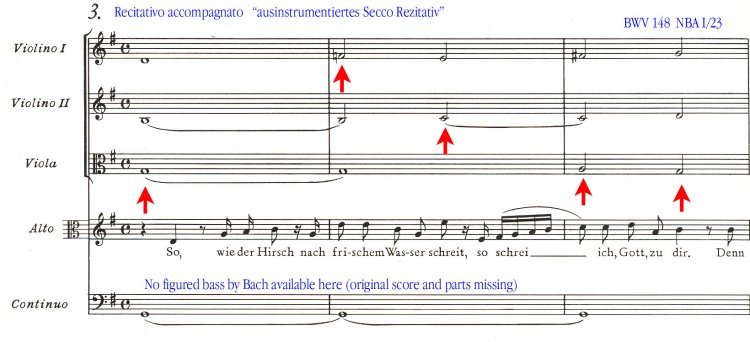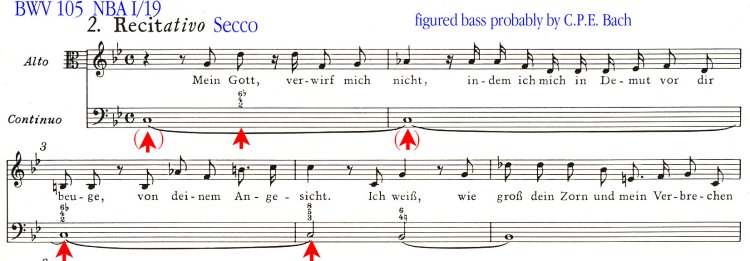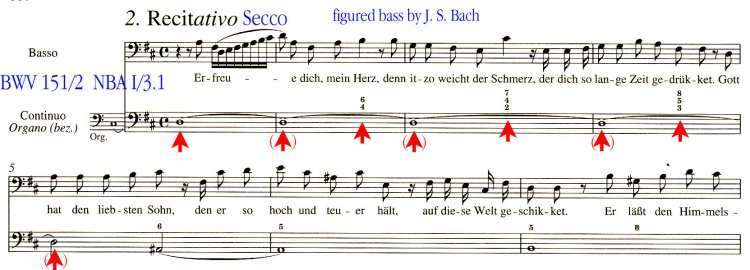|
|
Continuo in Bach’s Vocal Works - Part 4
Examples from the Score |
|
Thomas Braatz (in the discussion ‘Bass being "actually left out’, see: Continuo in Bach’s Vocal Works - Part 4 [General Topics]) wrote (June 17, 2004):
In order to see more precisely why a listener would want to follow along with a score during a performance or recording, I have posted a few samples of recitatives to illustrate how many HIP continuo players show a callous disregard for Bach’s intentions by eviscerating the continuo part when applying the ‘esoteric’ doctrine of shortened accompaniment to Bach’s secco recitatives which is accomplished as follows (these JPG files have been posted in the files section of the BachCantatas Yahoo Group as BWV105M2Secco; BWV140M2Secco; BWV148M3Acc; BWV151M2Secco):
Here is my explanation of what can be seen in each example/extract: |
| |
|
Cantata BWV 148 Mvt. 3 Accompagnato: |
|

|
|
I’ve included this ‘accompagnato’ recitative for comparison with the other ‘secco’ recitatives. The only difference here is that the chords usually left to the continuo player are written out in full. This, of course, makes it somewhat less free in style for the singer since all of the instruments and the voice must stay together. As a result, attending to the regular beats becomes much more important here than in the ‘secco’ recitative where only the basso continuo needs to follow the singer.
I have marked with arrows the change of chords which would otherwise in a secco recitative be written out as figured bass chords in the figured bass. Imagine this recitative sans instruments played in secco “HIP” style using the shortened accompaniment: you would probably hear the G-major chord played for about one beat at the very beginning, after which there would be complete silence for an additional 11 beats (this according to the Schering/Mendel/Harnoncourt/Dreyfus theory which would allow only the single chord to be played ‘in shortened fashion’ at the beginning of the long held note in the bass. Thereafter, nothing but 11 beats of silence in the continuo section. The singer lacks the necessary support which Bach had built into the music. [The HIP adherents are always quick to point out that the voice needs to be heard and the continuo could too easily cover up the voice – but I do not want to get into the ‘demi-voix’ ‘small HIP’ voice phenomenon at this point in this discussion.]
Instead of just one chord being sounded at the very beginning rather abruptly, there are at least 5 occasions where a basso continuo, if this were a secco recitative, could change the chord while still holding the long note all the way through in the bass. |
| |
|
Cantata BWV 105 Mvt. 2 Secco Accompaniment: |
|

|
|
In this secco recitative, the basso continuo player/group holds the bass note for 14 beats without interruption; at least that was the case until the HIP movement, beginning almost a half-century ago, began performing these recitatives in an entirely new way: You will hear the bass note with the implied chord sounded for about a beat or so, but after that the HIP continuo players will insert rests (explaining, if you wish to hear their made-up reason, that Bach found it easier to write the whole notes rather than inserting ‘all those rests’ by hand.)
You wonder about those ‘funny’ numbers (figured bass) which are left floating in the air but played rarely, if at all? These may be considered by HIP experts as extraneous, rather superfluous decorative symbols that were put there only to serve a didactic purpose for little children or beginners, but not to be taken too seriously by professional HIP artists.
The arrows in parentheses indicate places where a chord (not only the single long note in the bass) may be sounded (optional, left to the player.) |
| |
|
Cantata BWV 140 Mvt. 2 Secco Accompaniment: |
|

|
|
From the famous cantata “Wachet auf,” here is a secco recitative with a bass note that should be held for 10 beats during the course of which Bach has included indications for 3 additional chord changes (the figure bass (the small numbers, often in vertical columns.) If you were to hear this secco recitative performed in the traditional, non-HIP manner (this is still being done today by such non-HIP ensembles), you would hear the bass note held by the organ and the bassoon (perhaps even an additional member of the continuo group) for the entire duration of the 10 beats unceasingly! Over this foundation, the chord changes indicated by the figured bass are supplied by the organist while the singer enjoys having this firm support without feeling entirely abandoned by the continuo group. |
| |
|
Cantata BWV 151 Mvt. 2 Secco Accompaniment: |
|

|
|
Here is an example of a single bass note in the continuo being held for 18 beats!, or least that was once what Bach had intended. How would a HIP continuo player truncate this note? In an extreme instance, he/she might simply take it ‘by the rule’ as given in the ‘shortened accompaniment’ theory and play only the first note/chord for about 1 or 2 beats. Thereafter, nothing but silence, even when 3 figured bass figures floating above the bass note appear in the continuo part. Some HIP continuo players have had their performances (or their lack of performance – not playing the notes that Bach indicated) criticized so often that they have decided to ‘please both camps’ by ‘throwing in a little something extra’ (a short arpeggiated chord in the upper register – you don’t want to sound once again that bass note that you have quit playing some time ago – that would be too obvious to the listener.) Such a continuo player can then go home rather satisfied in knowing that he/she has attempted with such an inept compromise to appease both gods: Bach’s composition as he wrote it out (Bach almost always wrote out the figured bass in one of the original continuo parts that have come down to us) and one of the pillars of the HIP movement, the Schering/Mendel/Leonhardt/Harnoncourt/Dreyfus theory, which is based upon the notion that, under Bach, all of his players knew that they would be looking at notes and figured bass that were placed in their parts by Bach, but then they always remembered the ‘esoteric’ doctrine, that can not be adequately documented by musicologists today: What you see in the score/part is not what you play – you truncate the long-held bass notes radically and generally forget about the other figured bass indications that are floating above this note. This is an abhorrent compromise that begins to display, for all to see, the weaknesses of this rather silly doctrine.
The red arrows indicate where additional chords are sounded along with the continually held bass note with those arrows enclosed in parentheses possibly being optional and left up to the player to insert as needed or felt. |
| |
|
All snippets from NBA
Contributed by Thomas Braatz (June 17, 2004) |
|
|